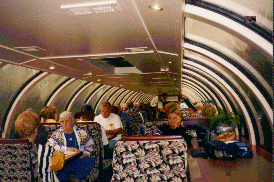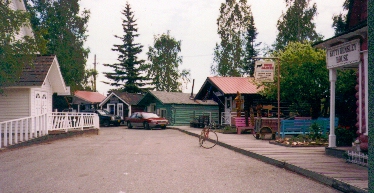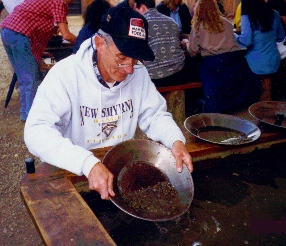Alaska Railroad Train to Fairbanks.
Growing up in a state where trains are for freight only, the idea of luxury passenger service, with domes and dining cars, held great allure. It would be a 12 hour trip, through forests, mountains, with moose and bear and beaver peering at us along the tracks.
 What one never considers, when booking a trip like this, is the possibility of bad weather. For the first 8 hours, all we saw outside the dome was rain. No moose, no bear, no Mt. McKinley.
What one never considers, when booking a trip like this, is the possibility of bad weather. For the first 8 hours, all we saw outside the dome was rain. No moose, no bear, no Mt. McKinley.
We were in one of about 8 domed cars. Most of the others were owned and operated by the various cruise lines. Each car had a small dining area on the "ground floor" - the meals were delicious, elegant and expensive.
When the train reached Denali, all the under-age crew (waiters and kitchen crew) got off our train and boarded the one going back to Anchorage, just as the Fairbanks teens got off the Anchorage train and boarded ours. This way, underage workers were all returned to their home city for the night.
Most of the tourists in our car got off at Denali and were replaced by other tourists continuing to Fairbanks, as we were.
North of Denali the rain stopped. We saw Dahl sheep, little white specks high on the mountain.
|
And so, 12 hours after boarding the train in Anchorage, we disembarked in Fairbanks, and took a cab to our Fairbanks B&B "The Downtown B&B" which we selected for its central location with the idea of walking everywhere.
Again, we were wrong. Fairbanks is low, and spread out over a wide area. It is not possible to walk to the points of interest. The next morning we rented a car.
The Downtown B&B was charming, the hosts friendly and very helpful. The bedroom was large and bright and airy, and the breakfasts were bountiful.
With a car, we still had to decide which sites to go to, and which places to pass up. We passed up the day on the paddlewheeler. We had to choose between two gold panning adventures, and which of the many excellent restaurants would serve us dinner? These are the choices we made:  Alaskaland --- In the travel guides Alaskaland sounds like an amusement park, but it is closer to Ameriflora in concept than to Disney. Created for a state exposition, it remains for the citizenry of Fairbanks to enjoy. Admission is free, and the gates are always open. Inside, it is charming. There is a "pioneer village" made of authentic log cabins that were moved to this site and today hold shops of all sorts.
Alaskaland --- In the travel guides Alaskaland sounds like an amusement park, but it is closer to Ameriflora in concept than to Disney. Created for a state exposition, it remains for the citizenry of Fairbanks to enjoy. Admission is free, and the gates are always open. Inside, it is charming. There is a "pioneer village" made of authentic log cabins that were moved to this site and today hold shops of all sorts.
At the end of the street is a small museum, displaying all kinds of tools and implements dating from the last century. But what was of especial interest to us was the show of Alaskan life based on the paintings of Rusty Heurlin.
Rusty Heurlin! The Painter Laureate of Alaska! His paintings depict every aspect of Alaskan Gold Rush era life, done in the realistic but painterly style of the Westport (Connecticut) Illustrators. As well he might, for Rusty grew up in Westport, and, in fact, worked as an usher at the Fine Arts Theater, working for Larry's father, George. Years later, when Rusty had made his fame in Alaska, he came back to Westport for a visit and gave George a set of placemats made with reproductions of some of his paintings. These placemats were in the family for years, and every time they were on the table, George would tell the story of Rusty Heurlin's visit.
From there we went to the University of Alaska's Museum . It is small, but wonderfully done, with all the native cultures represented, plenty of natural history and geography, and a 36,000 yr. old mummified musk ox! There was a video about the resettlement of the Aleuts during WWII, a piece of U.S. history that most of us "outsiders" know little about. On the grounds of the museum there were totem poles and a log fort dating from the fur trading days.
|
Thar's Gold in Them Thar Tourists!
Our next stop was the El Dorado Gold Mine, for which we had an early afternoon reservation. It is a total gold rush experience; we boarded a small "ore train" which soon filled up with tourists from the cruise busses, and chugged through the acreage where we were shown various elements of gold rush mining techniques. In the winter, the miners dug through the permafrost to bedrock using steam to melt the frost as they dug. The tunnels were held up by the permafrost. Outside the mine, the ore was piled up, to be panned down during the summer months when the soil was too fragile to hold up under tunneling.
 We left the train and took our places along the edge of a very long sluice, and a team of "miners" demonstrated panning. (Miners, rather than minors, although some were both) From there we went to a huge shed, which at first looked like a picnic pavillion with long tables and benches. But they were not tables, they were troughs of warm water, and we each were given a pan and a bag of ore and encouraged to extract all the gold to be found in the ore. The "miners" circulated amongst the tourists, offering help and advice.
We left the train and took our places along the edge of a very long sluice, and a team of "miners" demonstrated panning. (Miners, rather than minors, although some were both) From there we went to a huge shed, which at first looked like a picnic pavillion with long tables and benches. But they were not tables, they were troughs of warm water, and we each were given a pan and a bag of ore and encouraged to extract all the gold to be found in the ore. The "miners" circulated amongst the tourists, offering help and advice.
They told us that the gold, being heavier than the sand, would sink to the bottom as the sand was washed away. Amazingly, they were right! As the contents of the pan were reduced to just a few tablespoons of sand, bright golden flakes appeared! With a little bit of help, the rest of the sand was removed and the flakes stored in a little film cannister.
Larry was so successful in extracting the gold from his bag of ore that Tippi "allowed" him to finish her panning job while she videotaped the operation.
Our gold rush experience ended up in the gift shop. Our gold was assayed as being worth $13 and we bought a $20 locket to keep it in. Let's see, $25 each admissions, plus the $20 for the locket, minus the $13 worth of gold we took away with us. Yes, I'd say there was gold in them thar tourists! (But we didn't mind, we didn't mind at all. We had a wonderful time and learned a lot about the process).
|
We went on to the Ester Gold camp for dinner and the show. Dinner, an all-you-can eat buffet, with a specialty of Dungoness crab. But, sad to say, the crab they offered was snow-crab - good, but not Dungoness. The halibut was the best I ever tasted.
And then the show in the Malamute Saloon. A marvellous musical review, with song and dance and skits and jokes and some readings of the works of Robert Service. We shared a table with two men from Boston, and when we told them we used to live on Cheney St. they knew it well. "I wouldn't go into that arear even in the daytime" one of them said.
The next morning, we flew back to Anchorage where we rented a car and continued to Seward.
|





